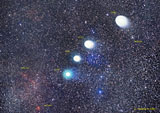
Comet Holmes, a periodic comet currently visible in the constellation Perseus, has been dubbed "the strangest comet to burst onto the celestial scene in our lifetime." In late October, it suddenly increased in brightness by almost a million-fold. Since then it has been visible by naked eye, although it has been dispersing and can now only be seen in relatively dark skies like at Dave's observatory outside of Temecula (definitely not in Los Angeles, where it never gets dark).
Daveís skyscape with the comet, taken about a week and a half after its outburst, was featured as NASAís Astronomy Picture of the Day on November 9th. Since the initial astrophoto, he has been going to Anza every weekend, weather permitting, to capture the fascinating evolution of the comet. It quickly went from looking like a star to an almost perfectly round ball, and it continues to expand (see his astrophoto page for several images). The diameter of the comet's coma exceeded that of the sun by early November, making Comet Holmes the largest object in our solar system, despite its puny mass.
 Another unusual thing about the comet is its slow speed. Some comets move
so fast that when they are photographed, the background stars appear as
streaks. With Holmes, Dave can track on the stars and still capture a sharp
image of the comet. Also, it is possible to make a composite of several
images spaced close together in one skyscape, looking like menehune
(Hawaiian gremlin) toeprints in the sky.
Unfortunately, the file size is already unmanageable; itís currently well
over a gigabyte and takes 10 minutes just to load into Photoshop. And Dave
expects the comet to be visible for several more months to come!
Another unusual thing about the comet is its slow speed. Some comets move
so fast that when they are photographed, the background stars appear as
streaks. With Holmes, Dave can track on the stars and still capture a sharp
image of the comet. Also, it is possible to make a composite of several
images spaced close together in one skyscape, looking like menehune
(Hawaiian gremlin) toeprints in the sky.
Unfortunately, the file size is already unmanageable; itís currently well
over a gigabyte and takes 10 minutes just to load into Photoshop. And Dave
expects the comet to be visible for several more months to come!
The bluish image (little toe) is the one that appeared on APOD. Dave scored a second APOD posting one week later, when he happened to capture a satellite rocket fuel dump while photographing Orion. Incredible!